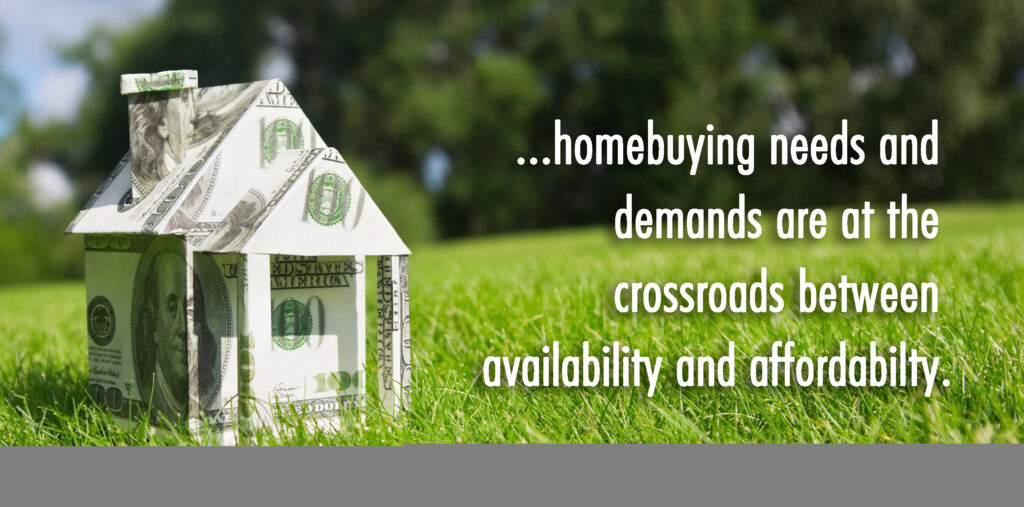“Limited inventory”. “Rising interest rates”. “Barbell of imbalance”. Many homebuyers and real estate professionals alike are finding themselves challenged by the law of scarcity in today’s market. Simply put, there are more buyers than there are homes to fill. Anyone in the home building and buying world is intimately aware of the impact presented to us with this unique situation. There are several factors creating this imbalance.
 First-time homebuyers who are starting families and move down buyers who are looking to downsize have put a strain on the inventory availability. The need for each group is similar, the wants may differ, but the need can be met with access to more inventory of affordable homes. With the average sales price of homes increasing exponentially, the opportunities for these buyers is continually diminished. Add in the threat that homes will now cost more because of rising interest rates, and a crisis is created. Interest rates are not currently creating a deferral impact upon buying trends, however, as the prices continue to rise, it prices many families out of the market entirely.
First-time homebuyers who are starting families and move down buyers who are looking to downsize have put a strain on the inventory availability. The need for each group is similar, the wants may differ, but the need can be met with access to more inventory of affordable homes. With the average sales price of homes increasing exponentially, the opportunities for these buyers is continually diminished. Add in the threat that homes will now cost more because of rising interest rates, and a crisis is created. Interest rates are not currently creating a deferral impact upon buying trends, however, as the prices continue to rise, it prices many families out of the market entirely.
What does this all mean? To put it bluntly, the market needs more homes for the fixed income and average income buyers. Meeting these buyers needs starts at a price point and includes flexible options. Fixed income buyers who are downsizing tend to fall into the group of sellers that are cashing in on the equity increases in their current homes. They may be retiring or reducing their workload, pushing them toward fixed income levels. However, first-time homebuyers have a different hurdle. These apartment and rental home buyers need better programs in place to help them get out of the rental trap. With the increased need for rentals came the increased cost of renting. Many of the options available for renters taps out their income which reduces the chances that they can save money for a down payment. A good rental history shows they can afford the home, but they don’t have the income set aside for a 20% down payment. Does your company offer incentives to first-time homebuyers? What can your trusted lenders do to help them?
Although it is a challenge for the buyers, it is a positive for sellers and builders who are looking to gain a profit after a long stretch of being at a standstill. This opportunity for growth for builders is understandably a cautious undertaking. Willingness to work with these buyers can be rewarding to builders but it is wise to take precautions to avoid the pitfalls of the past. Ensuring that you work with other professionals who are licensed properly and that you are providing a high quality, warranted homes will set you as a builder apart from the crowd. Many lenders are now requesting that a 10-year structural warranty is in place when the buyer is using FHA/VA and USDA financing. As a member in good standing with RWC, you are in a position to meet this requirement and can meet the buyers lending needs.
In conclusion, home buying needs and demands are at the crossroads between availability and affordability. Somewhere in the middle is exactly where builders should strive to be to reap the rewards. As a tradeoff, qualified buyers are willing to settle for higher interest rates if given the opportunity to achieve the long-term goal of homeownership. Scarcity is real, but buyers are abundant.
 This weekend marked the 48th anniversary of Earth Day. On April 22, 1970, millions of Americans came together to fight for a clean, sustainable environment and that fight still continues today. Consumer-awareness has increased over the years, and so has the demand for Earth-friendly products and procedures. According to the NAHB, and in conjunction with a series of studies conducted by Dodge Data & Analytics, “at least one-third of surveyed single-family and multifamily builders said that green building is a significant portion of their overall activity. And by 2022, this number should increase to nearly one-half in both sectors.”
This weekend marked the 48th anniversary of Earth Day. On April 22, 1970, millions of Americans came together to fight for a clean, sustainable environment and that fight still continues today. Consumer-awareness has increased over the years, and so has the demand for Earth-friendly products and procedures. According to the NAHB, and in conjunction with a series of studies conducted by Dodge Data & Analytics, “at least one-third of surveyed single-family and multifamily builders said that green building is a significant portion of their overall activity. And by 2022, this number should increase to nearly one-half in both sectors.”
You, as a builder, can have a big impact from the get-go; essentially starting with a clean slate for every home you build. How can you contribute to the home’s carbon footprint? Simply look around a typical house. There are opportunities everywhere to make improvements or conserve. Do you incorporate environmentally-friendly features such as water saving faucets and toilets, low VOC paints and adhesives, and energy-efficient appliances and systems? Not only is saving money for the long haul important to buyers, but the way the home itself impacts the future (and present) environment is also significant.
House hunters today have a lot of choices when it comes to choosing a builder. Will you measure up? Do you have special certifications such as LEED or Energy-Star? Have you won awards for your ecological principals? If green building is in your wheelhouse, then show off -- highlight these practices on your website, social media, on promotional materials, and by word of mouth! Those are exactly the types of things that consumers today are attracted to.
More and more builders are joining the green home movement with sensitivity to nature preservation and homeowner requests. Slowly but surely, eco-friendly elements are becoming the ‘standard’. If you haven’t done so already, incorporating just a few of these building practices will be beneficial for your business. With this buying preference in mind, there is much opportunity and value in this market. Prospects will certainly do their research when planning for their dream home and you may just win them over when Mother Nature is in your corner.
